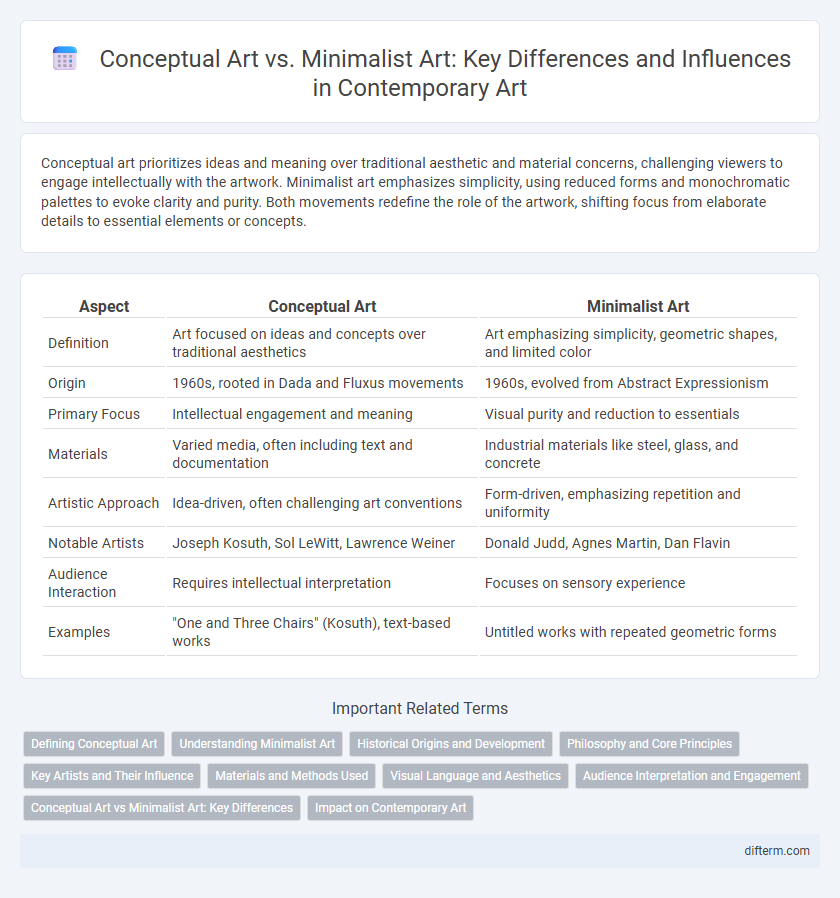Conceptual art prioritizes ideas and meaning over traditional aesthetic and material concerns, challenging viewers to engage intellectually with the artwork. Minimalist art emphasizes simplicity, using reduced forms and monochromatic palettes to evoke clarity and purity. Both movements redefine the role of the artwork, shifting focus from elaborate details to essential elements or concepts.
Table of Comparison
| Aspect | Conceptual Art | Minimalist Art |
|---|---|---|
| Definition | Art focused on ideas and concepts over traditional aesthetics | Art emphasizing simplicity, geometric shapes, and limited color |
| Origin | 1960s, rooted in Dada and Fluxus movements | 1960s, evolved from Abstract Expressionism |
| Primary Focus | Intellectual engagement and meaning | Visual purity and reduction to essentials |
| Materials | Varied media, often including text and documentation | Industrial materials like steel, glass, and concrete |
| Artistic Approach | Idea-driven, often challenging art conventions | Form-driven, emphasizing repetition and uniformity |
| Notable Artists | Joseph Kosuth, Sol LeWitt, Lawrence Weiner | Donald Judd, Agnes Martin, Dan Flavin |
| Audience Interaction | Requires intellectual interpretation | Focuses on sensory experience |
| Examples | "One and Three Chairs" (Kosuth), text-based works | Untitled works with repeated geometric forms |
Defining Conceptual Art
Conceptual art emphasizes the idea or concept behind the work rather than its aesthetic or material form, challenging traditional notions of art by prioritizing intellectual engagement. Artists like Sol LeWitt and Joseph Kosuth exemplify this movement, using text, instructions, and ephemeral materials to convey meaning beyond visual experience. This approach contrasts with minimalist art's focus on simplicity, form, and material presence, highlighting conceptual art's key characteristic: the primacy of thought over object.
Understanding Minimalist Art
Minimalist art emphasizes simplicity, focusing on basic geometric forms, clean lines, and monochromatic palettes to create an immersive visual experience. Unlike conceptual art, which prioritizes ideas and philosophical messages, minimalist art directs attention to the physicality and materiality of the artwork itself. Key figures like Donald Judd and Agnes Martin highlight how minimalism strips away excess to reveal pure aesthetics through repetition and spatial harmony.
Historical Origins and Development
Conceptual art emerged in the 1960s, emphasizing ideas over visual form, with pioneers like Sol LeWitt and Joseph Kosuth challenging traditional aesthetics by prioritizing intellectual engagement. Minimalist art, also arising in the 1960s, focused on simplicity and objectivity, with artists such as Donald Judd and Agnes Martin creating works characterized by geometric shapes and reduced color palettes. Both movements reflected a reaction against abstract expressionism but diverged in their approach: conceptual art valued meaning through language and concept, while minimalism stressed physical presence and form.
Philosophy and Core Principles
Conceptual art prioritizes ideas and intellectual engagement over aesthetic form, emphasizing the artist's intent and the message behind the work. Minimalist art focuses on simplicity and objectivity, reducing elements to fundamental geometric shapes and monochromatic palettes to highlight form and space. The philosophy of conceptual art challenges traditional artistic conventions, while minimalist art seeks purity and clarity through reduction.
Key Artists and Their Influence
Conceptual art pioneers like Sol LeWitt and Joseph Kosuth revolutionized artistic expression by prioritizing ideas over aesthetic form, profoundly influencing contemporary art theory. Minimalist artists such as Donald Judd and Agnes Martin emphasized simplicity and geometric precision, reshaping visual perception and spatial experience in the 1960s art scene. Both movements challenged traditional art conventions, leaving a lasting legacy on modern artistic practices and critical discourse.
Materials and Methods Used
Conceptual art prioritizes ideas and processes over traditional aesthetic and material concerns, often utilizing text, documentation, and ephemeral materials to convey messages. Minimalist art emphasizes simplicity and objectivity, employing industrial materials like steel, glass, and concrete with precise fabrication techniques to highlight form and space. Both movements challenge conventional art materials but diverge in their use of materials--conceptual art opts for transient, often non-traditional mediums, while minimalism focuses on durable, tangible substances.
Visual Language and Aesthetics
Conceptual art emphasizes ideas and meaning over visual form, using language and symbols as primary tools to challenge traditional aesthetics. Minimalist art prioritizes simplicity, employing geometric shapes, monochromatic palettes, and spatial purity to create an objective visual language that reduces art to its essential elements. Both movements redefine visual language by stripping away excess, but conceptual art engages cognition through symbolism while minimalism appeals to sensory perception through form and structure.
Audience Interpretation and Engagement
Conceptual art emphasizes ideas over form, inviting viewers to actively interpret the meaning behind the work, often requiring intellectual engagement and reflection. Minimalist art focuses on simplicity and geometric forms, encouraging audiences to experience the artwork through direct perception and sensory interaction. Both movements challenge traditional art interpretations but engage audiences differently: conceptual art through cognitive participation, and minimalist art through spatial awareness and visual presence.
Conceptual Art vs Minimalist Art: Key Differences
Conceptual art prioritizes ideas and concepts over traditional aesthetic and material concerns, often using text, performance, or found objects to challenge conventional art definitions. Minimalist art emphasizes simplicity, focusing on geometric shapes, monochromatic palettes, and industrial materials to create clear, objective forms. The key difference lies in conceptual art's focus on intellectual engagement versus minimalist art's emphasis on visual and spatial experience.
Impact on Contemporary Art
Conceptual art revolutionized contemporary art by prioritizing ideas and intellectual engagement over traditional aesthetics, challenging viewers to interpret meaning beyond visual forms. Minimalist art, with its emphasis on simplicity, geometric shapes, and monochromatic palettes, influenced contemporary art by stripping down complexity to essential elements, encouraging spatial awareness and sensory experience. Both movements reshaped artistic practices, expanding the boundaries of creativity and redefining the relationship between art, artist, and audience.
conceptual art vs minimalist art Infographic

 difterm.com
difterm.com